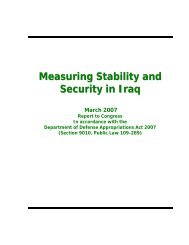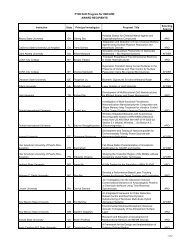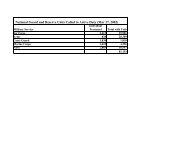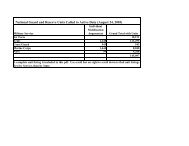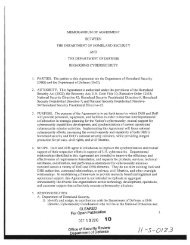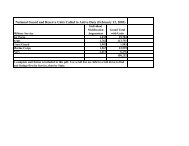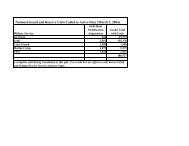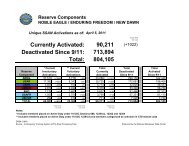Report - United States Department of Defense
Report - United States Department of Defense
Report - United States Department of Defense
You also want an ePaper? Increase the reach of your titles
YUMPU automatically turns print PDFs into web optimized ePapers that Google loves.
UNCLASSIFIED<br />
reviewed by MoPW personnel, U.S. <strong>Department</strong> <strong>of</strong> Transportation personnel, and the U.S. Army<br />
Rail Advisory Team in-theater. Suggestions have been made and changes have been accepted to<br />
the legal and regulatory framework. This comprehensive piece <strong>of</strong> legislation now only needs the<br />
review and approval <strong>of</strong> Parliament prior to being put into law. The legal and regulatory<br />
framework is an integral part <strong>of</strong> ensuring the ARA has the proper authority to execute its duties.<br />
Power<br />
Improvements to energy transmission and distribution systems continue to be one <strong>of</strong> the top<br />
priorities for the current infrastructure development strategy because <strong>of</strong> the foundational role it<br />
plays in fostering economic development and growth. During the reporting period, Afghanistan<br />
achieved significant progress towards capacity development and strengthening <strong>of</strong> energy<br />
institutions. However, a major challenge continues to be effective commercialization and<br />
efficiency in the sector. Currently, power is only available to one-third <strong>of</strong> the population and<br />
power imports, along with domestic generation, do not provide 24-hour supply to those<br />
connected. The sector requires extensive development in capacity and skills at every level.<br />
Major weaknesses <strong>of</strong> Afghanistan’s power sector are its lack <strong>of</strong> nationwide metering and pay<br />
mechanisms. This results in the overuse <strong>of</strong> low-cost and no-cost electricity, thereby limiting<br />
revenue potential and investment in the sector.<br />
The major power initiative in Afghanistan is USAID’s Power Transmission Expansion and<br />
Capacity (PTEC) project, whose aim is to strengthen the North East Power System (NEPS),<br />
expand it, and ultimately connect it to the Southeast Power System (SEPS). The NEPS brings in<br />
imported electricity from the Central Asian Republics to provide power to Kabul and the<br />
communities north <strong>of</strong> Kabul. The SEPS services the areas south <strong>of</strong> Kabul in the Kandahar and<br />
Helmand areas, drawing most <strong>of</strong> its power from the Kajaki Dam and, currently, from diesel<br />
generators in Kandahar City. The NEPS and SEPS transmission lines will connect the north and<br />
south with the Gardez region into one unified system. The Kajaki Dam and power plant requires<br />
structural and power generation refurbishments and upgrades. These projects will improve<br />
employment, manufacturing capabilities, and quality-<strong>of</strong>-life in the region. Estimated completion<br />
date for the majority <strong>of</strong> the project is December 2014, although the third turbine will not be<br />
installed until 2015.<br />
USAID’s Kandahar-Helmand Power Program (KHPP), which will improve distribution in the<br />
SEPS, has maintained activity on all project components, which include the rehabilitation <strong>of</strong> two<br />
substations (partially complete) and improvements to the Kandahar medium voltage network<br />
(early stages). Installation <strong>of</strong> unit two at Kajaki Dam was originally an <strong>of</strong>f-budget project and is<br />
now being implemented as an on-budget program through Da Afghanistan Breshna Sherkat<br />
(DABS), the national electric utility. The eight-month closure <strong>of</strong> the Pakistan GLOCs created a<br />
significant backlog <strong>of</strong> electrical materials required for this project and resulted in delays <strong>of</strong> some<br />
project components <strong>of</strong> KHPP. Following the reopening <strong>of</strong> the Pakistan GLOC in July 2012, all<br />
electrical equipment arrived at the project site. The Durai Junction substation, one <strong>of</strong> the KHPP<br />
components, is nearing completion, and the Breshna Kot substation is now progressing,<br />
following early subcontractor delays.<br />
164






